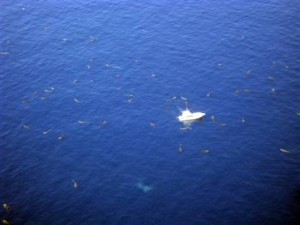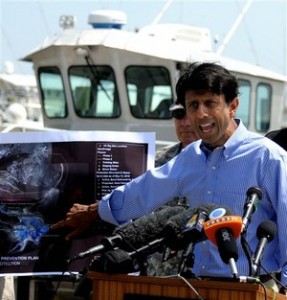 There’s no denying that a number of politicians seemed hell-bent on making a career out of sounding alarms about the catastrophic and lasting impact of the BP oil spill.
There’s no denying that a number of politicians seemed hell-bent on making a career out of sounding alarms about the catastrophic and lasting impact of the BP oil spill.
But a funny thing happened just days after BP managed to finally cap, though not kill, the well that was spewing an estimated 2.5 million gallons of oil into the Gulf Coast each day. The oil slick, which everyone feared would be turning white sand into black tar all along the coast, simply disappeared.
There’s just no data to suggest this is an environmental disaster. I have no interest in making BP look good – I think they lied about the size of the spill – but we’re not seeing catastrophic impacts. There’s a lot of hype, but no evidence to justify it.
This is the seemingly incomprehensible assessment of the scope of the damage that has been observed so far. It was offered by marine scientist Ivor Van Heerden in a July 29 report by TIME magazine. And here, according to this report, are the facts that support his assessment:
Yes, the spill killed birds – but so far, less than 1% of the birds killed by the Exxon Valdez. Yes, we’ve heard horror stories about oiled dolphins – but, so far, wildlife response teams have collected only three visibly oiled carcasses of any mammals. Yes, the spill prompted harsh restrictions on fishing and shrimping, but so far, the region’s fish and shrimp have tested clean, and the restrictions are gradually being lifted. And, yes, scientists have warned that the oil could accelerate the destruction of Louisiana’s disintegrating coastal marshes – a real slow-motion ecological calamity – but, so far, shorelines assessment teams have only found about 350 acres of oiled marshes, when Louisiana was already losing about 15,000 acres of wetlands every year.
Nevertheless, some in Congress are now fulminating about holding hearings to find facts to support the plainly politically-motivated charge that BP “carpet bombed” the gulf with “toxic” dispersants. The fish are fine (except for oysters that were killed not by oil but by fresh water that was pumped ill advisedly into their spawning areas to keep the oil at bay), the beaches are clean, and the wetlands are clearly going to be okay.
So what’s their beef with BP?! Especially since the Obama administration, namely the EPA, approved every ounce of dispersant BP used. Are these politicians in Washington not aware, or do they not care, that proselytizing such unfounded concerns about the safety of commercial seafood is doing more than anything BP has done to destroy the livelihoods of people living on the Gulf Coast?
In point of fact, the federal government is now considering requests by local officials to lift the ban on commercial fishing for wide areas of the Gulf; and life is returning to normal for many fishermen and merchants who just weeks ago were lamenting the end of their lives as they knew it. This is not to say, however, that these folks, and countless others, won’t be filing claims to get a cut of that $20 billion dollar fund President Obama extracted from BP to compensate victims for financial loss as well as emotional distress. And I urge them to be exceedingly thorough and forward thinking when filling out their claims to ensure they get as much cash as legally possible.
 At any rate, it is interesting to note that this report in TIME makes a mockery of Louisiana Governor Bobby Jindal’s Chicken Little demands – which got saturation media coverage – for $350 million to build sand berms and rock jetties to protect the marshes and wetlands. It cites the fact that the few berms the Coast Guard finally approved are now posing a far greater environmental impact than the oil itself; not least because they are already disintegrating into the Gulf.
At any rate, it is interesting to note that this report in TIME makes a mockery of Louisiana Governor Bobby Jindal’s Chicken Little demands – which got saturation media coverage – for $350 million to build sand berms and rock jetties to protect the marshes and wetlands. It cites the fact that the few berms the Coast Guard finally approved are now posing a far greater environmental impact than the oil itself; not least because they are already disintegrating into the Gulf.
There are a lot of alarmists in the bird world. People see oiled pelicans, and they go crazy.
(Coastal scientist Paul Kemp, a former Louisiana State University profession who is now vice president of the National Audubon Society, The New York Times, July 29, 2010.)
But I find it particularly interesting (and encouraging) that in recent days Coast Guard spotter planes and helicopters have been flying out on missions in search of oil to be skimmed and finding none: BP oil everywhere, and not a drop to see? No doubt you recall that, not so long ago, media reports had us believing that BP’s oil was everywhere and creeping, ominously enough, towards the ballyhooed Loop Current that would have oil defiling much of the Eastern Seaboard.
Now, after this disappearing act, scientists are falling all over themselves to explain that much of the oil, which latest government reports say amounted to 205 million gallons, has simply evaporated (by a biodegrading process called weathering). The rest they say was captured at the source by BP, broken up by dispersants, eaten up by microbes, or skimmed or burned by BP and Coast Guard clean-up crews.
 Despite all this, there are still some die-hard Chicken Littles who insist that this unfolding narrative of the disappearing oil is just another shameless attempt by BP’s PR machine to limit its liability. They insinuate that all of the oil is lurking underwater and will rise again … some day. Never mind that, just like Coast Guard missions over the Gulf, all submarine missions to find this oil and, more importantly, damage to marine life haves found nothing. Undeterred, these BP critics have been reduced to challenging us to either believe their claims about an environmental catastrophe or our lying eyes….
Despite all this, there are still some die-hard Chicken Littles who insist that this unfolding narrative of the disappearing oil is just another shameless attempt by BP’s PR machine to limit its liability. They insinuate that all of the oil is lurking underwater and will rise again … some day. Never mind that, just like Coast Guard missions over the Gulf, all submarine missions to find this oil and, more importantly, damage to marine life haves found nothing. Undeterred, these BP critics have been reduced to challenging us to either believe their claims about an environmental catastrophe or our lying eyes….
 Having said all that, I am not prepared to suggest that BP chief executive Tony Hayward has been vindicated and deserves an apology. Hayward, of course, is the empathetically challenged Englishman who was not only pilloried in the media but even lost his job for saying, among other purported gaffes, that:
Having said all that, I am not prepared to suggest that BP chief executive Tony Hayward has been vindicated and deserves an apology. Hayward, of course, is the empathetically challenged Englishman who was not only pilloried in the media but even lost his job for saying, among other purported gaffes, that:
I think the environmental impact of this disaster is likely to have been very, very modest.
But I feel obliged to note that even I’m on record suggesting that people, including President Obama, were overhyping the potential impact of the spill. For in the immediate aftermath this “worst environmental disaster in U.S. history,” here’s how I ended a commentary in which I pooh-poohed assertions that it would turn out to be Obama’s Katrina:
The infrequency of big spills is extraordinary considering the size of the offshore oil industry that provides Americans with affordable energy. According to the Interior Department’s most recent data, in 2002 the Outer Continental Shelf had 4,000 oil and gas facilities, 80,000 works in offshore and support activities, and 33,000 miles of pipeline. Between 1985 and 2001, these offshore facilities produced seven billion barrels of oil. The spill rate was a minuscule 0.001%.
According to the National Academy of Sciences … only 1% of discharges in North America are related to petroleum extraction. Some 62% of oil in U.S. waters is due to natural seepage from the ocean floor, putting 47 million gallons of crude oil into North American water every year.
(BP Oil Spill: Obama’s Katrina? The iPINIONS Journal, citing report in the Wall Street Journal, May 3, 2010)
Back then I hoped this information would provide an informative and reassuring perspective on this spill. Today, with the disappearing oil, I hope it will inspire us to say thanks to Mother Nature for her seemingly infinite ability to clean up not just her own mess but these man-made ones as well….
Related commentaries:
BP Oil Spill: Obama’s Katrina
* This commentary was originally published yesterday, Monday, at 5:01 am.
Leave a Reply
You must be logged in to post a comment.